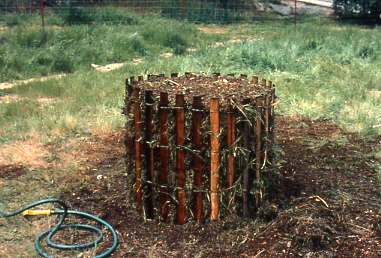|
The Compost Process
The chemical process necessary to turn garden trimmings and kitchen scraps into good compost requires carbon, nitrogen, water, oxygen, and microorganisms such as bacteria and fungi.
Compost piles which are relatively cool, often harbor insects (such as spring tails and beetle larva), nematodes, fermentation mites, centipedes, millipedes, sow bugs, pill bugs, and earthworms, which assist in the decomposition process.
Some less desirable creatures, such as flies, ants, earwigs, snails, and slugs are also attracted to compost piles. To discourage these less welcome creatures try turning and moistening a pile more often.
Heat will build up in your pile if the material you use has the proper ratio of carbon and nitrogen. Frequent turning and watering will help maintain high temperatures, by supplying the oxygen and moisture necessary for complete and rapid breakdown.
The smaller the particle size, the faster the material can break down. There are mulching mowers which can help to shred plant materials and leaves; chipper/shredders can reduce the size of fairly large material, but they are expensive and need room for storage.
How to Make Compost
The optimum size for a compost pile to heat up properly and maintain temperature is a minimum of 3x3x3 feet. For the composting process to work most effectively, material to be composted should have a carbon to nitrogen ration of 30/1. This can not be measured easily, but experience has shown that mixing equal volumes of green plant material with equal volumes of natural dry plant material will give approximately a 30/1 carbon to nitrogen (C/N) ratio.

Materials high in carbon are referred to as browns and include such materials as autumn leaves, straw, woody stems, bark, mixed paper, newspaper and cardboard, wood chips or sawdust.
Green or nitrogen-rich materials are: vegetable scraps, coffee grounds, grass clippings, manure, leaves from green, newly pruned plant material, shredded corn stalks, and shredded natural fibers such as cotton, fleece, hemp, and burlap.
If a material is green when it is cut or harvested, it will lose some nitrogen if left to dry out before shredding, but it is still green. Leaves that have fallen from a tree, as in autumn leaves, are mainly carbon because the nitrogen has returned to the roots due to the shortening day length and cooling temperatures. Coffee beans, although brown in color from roasting, were harvested when green; therefore they are “green” even after roasting.
If you have too little nitrogen and your pile won’t heat up, you can add a small amount of nitrogen fertilizer, such as ammonium sulfate, to your pile when turning it. If there is too much nitrogen there will be a strong odor of ammonia, but adding a little sawdust in the area of greatest odor can help.
Do not add the following to your compost pile:
- Animal feces from dogs, cats, and other carnivorous animals, (herbivorous animal manure such as chicken, goat, rabbit, cattle, elephant, is OK)
- Ashes ( too alkaline)
- Weeds which have already formed seeds
- Diseased plants
- Dairy or meat products
- Bones, fish, lard, mayonnaise, peanut butter, oils, bakery goods (may draw critters to the pile, also take a long time to decompose) Palm fronds (too fibrous, difficult or impossible to shred, require too much time to decompose)
- Walnut husks and walnut leaves (require too long a compost time, inhibit the growth of some plants such as tomatoes)
- Rose clippings (avoid because of the thorns)
|
